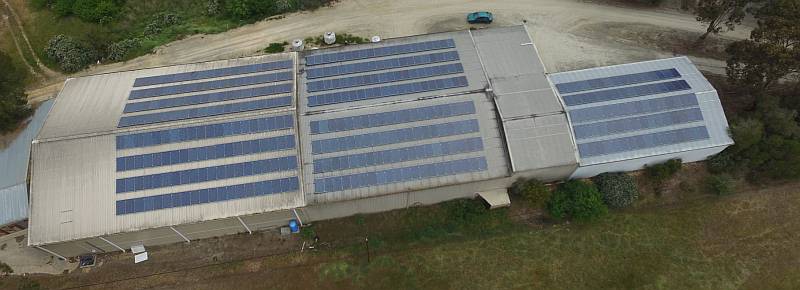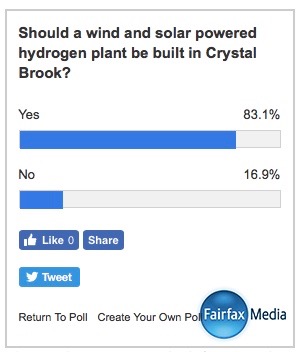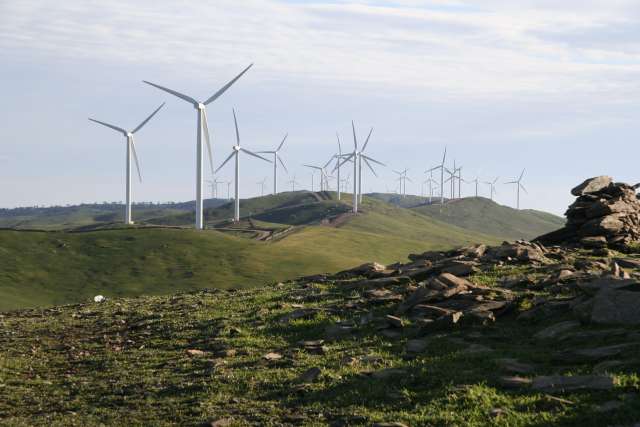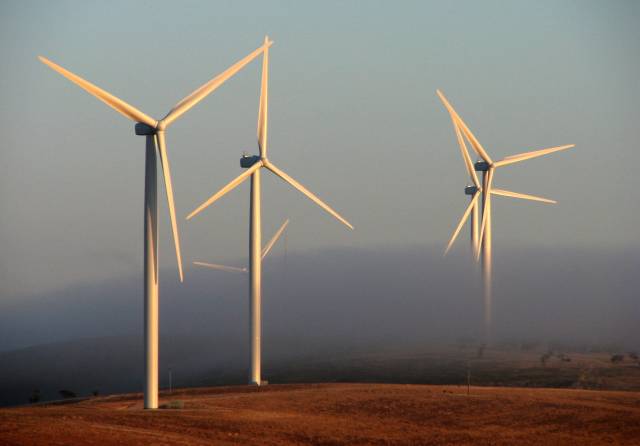| ||||
Is 100% renewable energy a practicality?
I have shown in another page on this site that Mid North South Australia generates far more electricity, renewably, than its total electricity consumption and it abates more CO2 emissions than it produces. That is, while Mid North SA does import non-renewable electricity at times, when the wind isn't blowing or the sun isn't shining, it exports far more renewable electricity than the fossil-fuelled electricity that it imports.At the time of writing, while there was quite a bit of roof-top solar power, the Clare and Gilbert Valleys Council district had only one wind farm and no utility-scale solar. (However, as is shown below, that one wind farm generates about 28 times as much renewable energy as all the small-scale solar in the whole of the Clare and Gilbert Valleys.)
Council itself could do more. Just installing solar panels on the roofs of council buildings would save money as well as displacing fossil-fuelled electricity.
Council candidates
One of the first things that we can do toward pressing the Clare and Gilbert Valleys Council to more toward responsible renewable energy is to elect the right councillors.I note that only one of the candidates for this year's election mentioned in their self-descriptions the word 'environment'; not one mentioned 'climate', 'renewable', 'sustainable', 'emissions' or 'carbon'. Not a promising start.
The candidates
| Name | Contacted | Responded |
|---|---|---|
| Alan Rye | 26th Oct | 26th Oct |
| Cate Hunter | 22nd Oct | 26th Oct |
| Ann Alder | 23rd Oct (post) | Not yet |
| Bartholomaeus | 23rd Oct | 23rd Oct |
| Christopher Boxall | 22nd Oct | Not yet |
| Ian Burfitt | 23rd Oct | 26th Oct |
| Elizabeth Calvert | 23rd Oct | Not yet |
| Leon Bruhn | 23rd Oct | 30th Oct |
| Brian Koch | 23rd Oct | Not yet |
| Portia Stanton-Noble | 23rd Oct | Not yet |
| Nedd Golding | 23rd Oct | 26th Oct |
| Lucy Patricia Drummond | 23rd Oct | 25th Oct |
My questions to the candidates:
Do you accept the reality of anthropogenic climate change (ACC)?On a scale of 1 to 10 where 1 is very low and 10 is very high, what importance do you feel that climate change should be given by council?
On a scale of 1 to 10 where 1 is very low and 10 is very high, what importance would you give to Council acting to minimise its greenhouse emissions?
Many councils Australia-wide have committed to high levels of adoption of renewable energy or reduction to the greenhouse gas emissions that they are responsible for. (See Who wants renewables: regional councils for a list of some of the councils that have committed.) On a scale of 1 to 10 where 1 is very low and 10 is very high, what support would you give to making some such commitment on behalf of CGVC?
| 1-2 | 3 | 4-6 | 7-8 | 9-10 |
| Very low | Moderately low | Medium | Moderately high | Very high |
The candidates' answers
The candidates' answer will be copied here as I receive them. When a candidate gave a detailed answer I have copied it to the appendix.| Name | Acceptance of ACC | Importance that should be given by Council to climate change | Importance of acting to minimise emissions | Support for Council making a public commitment | Detailed response |
|---|---|---|---|---|---|
| M. Bartholomaeus | Yes | 7 (moderately high) | 8 (moderately high) | 7 (moderately high) | Below |
| L. Drummond | Yes | 9-10 (very high) | 9-10 (very high) | Below | |
| A. Rye | "My answer to all of your questions is ABSOLUTELY" | Below | |||
| C. Hunter | Ms Hunter has not yet answered these questions but has given a detailed answer | Below | |||
|
|
Polls show how popular renewable energy is Australia-wide and locally
|
Australians love renewable energy
A Lowy Institute poll carried out on 1,200 Australian adults on 2018/06/20 showed that 84% of Australians wanted the government to "focus on renewables, even if this means we may need to invest more in infrastructure to make the system more reliable". 60% of the people polled accepted that "global warming is a serious and pressing problem" and wanted action even at significant costs, only 10% believed that global warming was in doubt.The Conversation provided a summary of the poll results on renewables and climate change. See the Lowy Institute site for the full results.
According to a fact-check done by The Conversation back in March 2016, 16.5% of Australian householders had gone to the expense of installing solar power. This was probably the highest percentage in the world.
Local people love renewables
An online poll that was conducted by a local newspaper (results in the screen-shot on the right) indicated overwhelming support for the Crystal Brook Energy Park with five of every six respondents in favour of the project. It is a good indication of how popular renewable energy is with the people in the Mid North Region.I've written more on the background to this poll on another page on this site.
|
|
Wentworth by-election
At the time of writing this section, 4pm 2018/10/21, the day after the Wentworth by-election, the outcome was not settled. According to Wikipedia "the Liberal Party of Australia and their predecessors have continuously held Wentworth since the inaugural 1901 election". At the 2016 election Malcolm Turnbull was elected for Wentworth with a 17.75% margin, making it "the fifth-safest Liberal seat in the nation".Disillusionment with the treatment of Mr Turnbull when he was dumped as Prime Minister by the Parliamentary Liberal Party, disgust with the treatment of refugees and frustration among the Australian people over lack of energy policy wiped out that 17+% margin at the by-election, making it, I believe, the biggest swing in an electorate in Australian history.
Disgust and disappointment with the government's failure to seriously attack the climate change disaster was a major factor in this swing. The Australian people want more renewables, not the protection of the dying coal industry.
|
|
Clare and Gilbert Valleys Council district a laggard
As mentioned above, Mid North SA as a whole – the five council districts of: Clare and Gilbert Valleys, Goyder, Northern Areas, Port Pirie Regional, Wakefield Plains together – generate far more renewable electricity than the fossil-fuelled electricity they import.However, the Clare and Gilbert Valleys Council district, on its own, is a relative laggard, it has only one wind farm (actually, most of one wind farm) and no utility scale solar power.
The Port Pirie Regional local government area is the other laggard of the Mid North, with a council that seem to be opposed to renewable energy developments, to the economic disadvantage of the community and in spite of the popularity of renewable energy with the local people as shown in the Flinders News poll. (See Tale of Two Cities and Let's have a progressive Port Pirie.)
Jamestown, the main town in the Northern Areas local government area, has reaped great advantages from the many nearby wind farms, and most of the people of Snowtown, in the Wakefield Plains council district, are very happy with their nearby wind farm (the most productive in Australia at the time of writing).
In the C&GV area there are some very creditable solar power installations on homes and businesses such as the winery pictured above, but the only utility-scale renewable energy development in the district is the relatively small, by Mid North standards, 129 MW Waterloo Wind Farm (almost entirely in the C&GVC area). The 125 MW Chaff Mill Solar Farm has been proposed north-east of Mintaro.
I believe that the Clare Valley, with its reputation as a top tourism and premium wine producing district, could and should do better.
|
|
Council's renewable energy installations
I have been informed that Clare and Gilbert Valleys Council's only solar is at Auburn Recreation Ground. "There are 3 systems in total:- Old Football Clubroom, 10 kilowatts;
- Kiosk, 6 kilowatts and
- Bowling Club, 4.5 kilowatts."
As mentioned above, a number of city and regional councils are taking strong action on climate change, surely our local government can do better than this!
|
|
How close is the Clare and Gilbert Valleys area to 100% net renewable energy?
How much renewable energy is generated in the area compared to how much energy is consumed? How much greenhouse emission is abated by the area's renewable energy compared to the emissions coming from the area? Both questions involve some fairly well known values and some that have to be approximated.Renewable energy installations in the Clare and Gilbert Valleys area
Small-scale installations
The data below were extracted from the Clean Energy Regulator's postcode data files, 2018/10/25.The following table lists the number of small-scale (less than 100 kW) solar installation and the total installed power of the small-scale solar installation by postcode for those postcode areas that are mainly within the Clare and Gilbert Valleys Council district.
| Postcode | Town(s) | No. of installations | Total rated output in kW | |
|---|---|---|---|---|
| 5410 | Stockport | 61 | 252 | |
| 5411 | Tarlee | 57 | 233 | |
| 5412 | Riverton/Rhynie | 252 | 958 | |
| 5413 | Marrabell/Waterloo | 157 | 672 | |
| 5414 | Manoora | 21 | 70 | |
| 5415 | Mintaro | 32 | 146 | |
| 5451 | Auburn | 158 | 693 | |
| 5452 | Watervale | 86 | 632 | |
| 5453 | Clare | 853 | 4,431 | |
| Total | C&GV | 1677 | 8,088 | |
|
Assuming a capacity factor of 18% for these solar PV installations an annual generation of 12.8 GWh can be calculated.
Medium-scale installations
Small-scale solar photo-voltaic (PV) energy installations, I believe, are defined as those smaller than 100 kW, I don't think that there is an officially drawn between medium- and large-scale projects. The solar power installation on the winery in the picture, with about 470 panels, if it is in fact 120 kW as I approximated, would probably be called medium scale. The Australian PV Institute site, 2018/10/27, stated that there were no solar power installations in the C&GV local government area greater in size than 100 kW.Perhaps a reasonable demarkation between medium- and large-scale would be 1000 kW (1 MW).
Large-scale installations
Waterloo Wind Farm, total installed capacity 129 MW. 42 of the 43 turbines of the Waterloo Wind Farm are in the C&V area; an installed capacity of 126 MW.Working on that 126 MW together with a capacity factor of 33% an annual generation of 373 GWh can be calculated (364 GWh in the C&GV area), about 28 times all the small scale solar installations in the Clare and Gilbert Valleys combined.
Chaff Mill Solar Farm, proposed, installed capacity 125 MW. Assuming a capacity factor of 22% an annual generation of 241 GWh can be calculated.
Total renewable electricity generation
So the total generation of the small-scale solar and the part of the Waterloo Wind Farm in the C&GV area is about 377 GWh per year.Energy consumption and emissions
The population of the Clare and Gilbert Valleys in the 2016 Census was 9,023; that was 0.037% of the total Australian population of 24.6 million.Electricity
Total electricity generation in Australia in 2015-16 was 257 terawatt hours (TWh) (Australian Energy Update 2017). Working on the (rather dubious) assumption that per-capita electricity consumption in the C&GV area is the same as for Australia as a whole we can approximate power consumption for the area: 0.037% of 257 TWh is about 94 GWh per year.Emissions
Total emissions for Australia (about 2014) were 538 million tonnes of greenhouse gasses per year, so on average each Australian is responsible for 23 tonnes each year. So, based on the (rather dubious) assumption that the per-capita emissions in the C&GV area is the same as for the whole of Australia we can approximate the region's annual emissions at around 208,000 tonnes.Abatement
Emissions intensity in tonnes of CO2 from:- Brown coal fired power stations is about 1 tonne/MWh;
- Black coal fired power stations is about 0.8 tonne/MWh;
- Gas fired power stations is about 0.5 tonne/MWh;
Considering the very approximate nature of these calculation I wouldn't dare to say that abatement is greater than emissions in the Clare and Gilbert Valleys.
Bottom line
It seems, from the above calculations, that there is very little doubt that renewable electricity generation in the C&GV area is several times electricity consumption. Calculations for emissions and abatement are much more approximate, but it would seem that they are at least of similar magnitudes.It also seems that about 96% of the electricity generation and consequent abatement is attributable to the Waterloo Wind Farm.
|
|
Misconceptions
Some misconceptions about renewable energy have surfaced in my discussions with council candidates.Cost
Renewable energy in the forms of wind and solar PV is cheaper than new-build coal-fired and much cheaper than nuclear power stations. That is why British billionaire Sanjeev Gupta is investing a billion dollars in renewable energy in Australia, much of it in the Spencer Gulf region.The misconception about the cost of renewable energy is so common that I've written a page devoted to it.
Government subsidies
While small-scale roof-top solar PV is subsidised I don't think utility-scale PV is, and wind farms are not subsidised. At the present the owners or operators of utility-scale PV and wind farms do receive a payment for each megawatt of electricity they generate. I believe this adds about 3-5 cents to each unit of renewable power that consumers buy; that is 3-5 cents in the typically 35 cents per kilowatt-hour that we pay.On the other hand, the fossil fuel industry is heavily subsidised. In May 2015 The IMF estimated the subsidies going to (mainly) fossil fuels. They put the figure at $5.3 trillion per year (or about $10 million per minute).
I have written more on this on another page on this site.
Wind farms
The only wind farm in the C&GV district, Waterloo, has received more than its share of criticism. On the other hand I believe that the Snowtown wind farm had very little; I remember the then Mayor of the Wakefields Plains Council at the sod-turning ceremony of the second stage of Snowtown saying that he knew of no negativity and I recall a Snowtown woman who happened to be working on a Lions BBQ with me saying that "the wind farm was the best thing that ever happened to Snowtown".I have been a member of the Waterloo Wind Farm Community Liaison Committee since its inception and I've studied and written about wind farms in Australia for over fifteen years.
My impression is that a small group of unscrupulous opponents can stir up a lot of fear and bad feeling. If it happens that there is no such core of dishonest people, as in the Snowtown case, and with most of the wind farms near Jamestown, then there is no bad feeling and development goes smoothly.
As mentioned elsewhere on this page we must take strong action, at all levels, federal, state, local government, and as individuals if we are to limit climate change, and the Waterloo Wind Farm generates about 28 times as much renewable energy as all the solar power installations in the C&GV area combined. I would very much like to see Council encourage any further wind power developments that may be proposed in the district.
|
|
Climate change
| ||||
|
The photo on the right was taken in May 2008, the one below in May 2018.
I've written more on the loss of the small remnant population of red stringybarks in the Clare Valley on another page.
The only red stringybarks (Eucalyptus macrorhyncha) in South Australia are in the hills in and near Spring Gully Conservation Park west of Sevenhill in the Clare Valley. They are at great risk from climate change.
Is climate change really happening and is it caused by mankind?
In discussions with candidates for the C&GV council I have found that several at least are unsure. The scientific evidence is overwhelming; about 99% of papers published in peer-reviewed climate science journals accept the fact of anthropogenic climate change (ACC, climate change caused by mankind).Perhaps this does not mean much to people who are less familiar with science. I've written a page that gives many other reasons to accept the truth of ACC.









